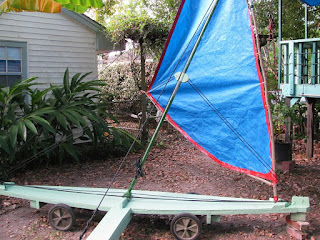http://wikiproa.pbworks.com/w/page/engravings-and-models
http://www.musee-marine.fr/public/virtuel/touslesbateauxdumonde/index.html
~ Sustainable Seafaring from Oceania. History, Design, and Relevance ~
October 29, 2010
October 27, 2010
Star Rigging - the grand endeavor...
Introduction to Star-Rigging
Simple is absolutely best. The only reason to tinker with the already
excellent Micronesian rig is to find a way to shunt the rig
single-handedly in larger sizes, breezier conditions, and rougher sea
states. The goal is to tilt the mast under control with backstays and at the same time move the yard to the other end of the boat.
I wanted a way to pair the line that would tilt the mast and the line that would move the yard over but discovered that those two lines moved through differing distances and at different rates. Eventually I stumbled upon the present arrangement which allows those two lines to travel together, "married" as it were at a central attachment point, a ring, where all the lines meet and are snugged up.
The traveling block up on the mast allows the introduction of more (needed) line into the continuous backstay system and, oddly enough, the height of the block is not that critical.
A tackline moves the yard from one end to the other. The tackline and the continous backstay work in trandem and accomplish the shunt with the operator working from amidships at the base of the mast, a good secure location.
I went for the largest size model I could possibly patch together and I do mean patch together! I've built this almost entirely with found material. God is good and at each stage provided whatever material I've needed:The hull is of scrap woodI wanted a way to pair the line that would tilt the mast and the line that would move the yard over but discovered that those two lines moved through differing distances and at different rates. Eventually I stumbled upon the present arrangement which allows those two lines to travel together, "married" as it were at a central attachment point, a ring, where all the lines meet and are snugged up.
The traveling block up on the mast allows the introduction of more (needed) line into the continuous backstay system and, oddly enough, the height of the block is not that critical.
A tackline moves the yard from one end to the other. The tackline and the continous backstay work in trandem and accomplish the shunt with the operator working from amidships at the base of the mast, a good secure location.
...
The mast is a fence post
The sail, post-Katrina blue polytarp
The spars are Mimosa branches
The lines are black poly from work
The sheaves are made of 2 x 4's
And so on...
With this model I intended to "make or break" the concept.
This is the completed 12 foot model. Properly speaking, this is a "mock-up" built to further test a rig innovation. A small prototype was built earlier and performed well enough to justify a further exploration of the concept with a larger model.
October 26, 2010
In action
Here is the 12 foot model in action. The roughly fashioned parts work well and even with its cheap construction this model has yielded some good data and performs OK - 4 shunts in 30 seconds is respectable!
With further improvement, I'd rig my next proa this way. It should be practical in the 16 footer to 20-something foot range.
October 25, 2010
Another shot
This is another shot, slightly zoomed in at the end. The rigging shows up a little better.
October 20, 2010
October 13, 2010
The original 6 foot prototype model of Star-Rigging
This is the original 6 foot model, built in 2004. You can see that the general idea works well enough to explore further. Just by pulling a pair of lines (which are joined together) the mast tilts and the sail travels the length of the boat to arrive at the "new bow" simultaneously.
Subscribe to:
Comments (Atom)











